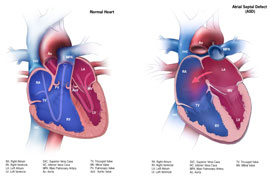Facts about Atrial Septal Defect
Pronounced ey-tree-uhl sep-tl dee-fekt
An atrial septal defect is a birth defect of the heart in which there is a hole in the wall (septum) that divides the upper chambers of the heart (atria). A hole can vary in size and may close on its own or may require surgery. An atrial septal defect is one type of congenital heart defect. Congenital means present at birth.
As a baby develops during pregnancy, there are normally several openings in the wall dividing the upper chambers of the heart (atria). These usually close during pregnancy or shortly after birth.
Learn more about how the heart works »
If one of these openings does not close, a hole is left, and it is called an atrial septal defect. The hole increases the amount of blood that flows through the lungs and over time, it may cause damage to the blood vessels in the lungs. Damage to the blood vessels in the lungs may cause problems in adulthood, such as high blood pressure in the lungs and heart failure. Other problems may include abnormal heartbeat, and increased risk of stroke.
The Centers for Disease Control and Prevention (CDC) recently estimated that each year about 1,966 babies in the United States are born with an atrial septal defect.1 It can also occur with other heart defects.
Causes and Risk Factors
The causes of heart defects such as atrial septal defect among most babies are unknown. Some babies have heart defects because of changes in their genes or chromosomes. These types of heart defects also are thought to be caused by a combination of genes and other risk factors, such as things the mother comes in contact with in the environment or what the mother eats or drinks or the medicines the mother uses.
Read more about CDC’s work on causes and risk factors »
Diagnosis
An atrial septal defect may be diagnosed during pregnancy or after the baby is born. In many cases, it may not be diagnosed until adulthood.
During Pregnancy
During pregnancy, there are screening tests (prenatal tests) to check for birth defects and other conditions. An atrial septal defect might be seen during an ultrasound (which creates pictures of the body), but it depends on the size of the hole and its location. If an atrial septal defect is suspected, a specialist will need to confirm the diagnosis.
After the Baby is Born
An atrial septal defect is present at birth, but many babies do not have any signs or symptoms. Signs and symptoms of a large or untreated atrial septal defect may include the following:
- Frequent respiratory or lung infections
- Difficulty breathing
- Tiring when feeding (infants)
- Shortness of breath when being active or exercising
- Skipped heartbeats or a sense of feeling the heartbeat
- A heart murmur, or a whooshing sound that can be heard with a stethoscope
- Swelling of legs, feet, or stomach area
- Stroke
It is possible that an atrial septal defect might not be diagnosed until adulthood. One of the most common ways an atrial septal defect is found is by detecting a murmur when listening to a person’s heart with a stethoscope. If a murmur is heard or other signs or symptoms are present, the health care provider might request one or more tests to confirm the diagnosis. The most common test is an echocardiogram which is an ultrasound of the heart.
Treatments
Treatment for an atrial septal defect depends on the age of diagnosis, the number of or seriousness of symptoms, size of the hole, and presence of other conditions. Sometimes surgery is needed to repair the hole. Sometimes medications are prescribed to help treat symptoms. There are no known medications that can repair the hole.
If a child is diagnosed with an atrial septal defect, the health care provider may want to monitor it for a while to see if the hole closes on its own. During this period of time, the health care provider might treat symptoms with medicine. A health care provider may recommend surgery for a child with a large atrial septal defect, even if there are few symptoms, to prevent problems later in life. Surgery may also be recommended for an adult who has many or severe symptoms. Surgery involves fixing the hole and may be done through cardiac catheterization or open-heart surgery. After surgery, follow-up care will depend on the size of the defect, person’s age, and whether the person has other birth defects.
References
- Parker SE, Mai CT, Canfield MA, et al; for the National Birth Defects Prevention Network. Updated national birth prevalence estimates for selected birth defects in the United States, 2004-2006. Birth Defects Res A Clin Mol Teratol. 2010;88:1008-16.
- Gilboa SM, Correa A, Botto LD, Rasmussen SA, Waller DK, Hobbs CA, et al. Association between prepregnancy body mass index and congenital heart defects. Am J Obstet Gynecol 2010;202:51.e1-10.
- Correa A, Gilboa SM, Besser LM, Botto LD, Moore CA, Hobbs CA, et al. Diabetes mellitus and birth defects. Am J Obstet Gynecol 2008;199:237.e1-237.e9.
- Malik S, Cleves MA, Honein MA, Romitti PA, Botto LD, Yang S, et al. Maternal Smoking and Congenital Heart Defects. Pediatrics 2008; 121;e810-e816.
Contact Us:
- Centers for Disease Control and Prevention
National Center on Birth Defects and Developmental Disabilities
Division of Birth Defects and Developmental Disabilities
1600 Clifton Road
MS E-87
Atlanta, GA 30333 - 800-CDC-INFO
(800-232-4636)
TTY: (888) 232-6348
New Hours of Operation
8am-8pm ET/Monday-Friday
Closed Holidays - cdcinfo@cdc.gov





